page 2
http://threesology.org
| What is time pg 1 | What is time pg 2 | What is time pg 3 | What is time pg 4 | What is time pg 5 | What is time pg 6 | What is time pg 7 | Time Travel Considerations |
If someone replies to you with the phrase "in a second" or "in a minute", the length of time can vary from person to person. Though we know how long a second and minute are actually measured, the words are not always strictly adhered to in definition. They thus become used as generalized expressions with no set enumeration... even though impatience may view them as always being too long no matter who employs them as a measure of delay. Indeed, it may be customary for some to always show up late or early for school, work, date, social gathering or entertainment venue though no one takes close notice of the actual amount of enumerated time on each and every occasion. Frequently, there are reasons or excuses for being early or late... or even on time, thus presenting us with three options relative to one's personal notion of time keeping... and is a division of time noted by Alan Dundez in his "The Number Three in The American Culture" as cited as a chapter from the book "Every Many His Way". Yet, time constraints can be put to bad usage as anyone having to deal with the government knows and has been forced into a limitation that often is of more value for the bureaucracy than assisting individual lives which are independent of government-designed schedules that can be used to assist the government in taking advantage of people... particularly when there is property or money involved and the people have no actual recourse or person to turn to for additional assistance.
In making analogies which attribute Time to some reference involving water or at least the flow of a liquid if not air as a gas, the notion of "eddies" needs to be taken into account since the "Arrow of Time" may be the name of a vessel that uses alternative currents involving solids, liquids, gases, and/or plasma. Does time "flow" in a single direction or multiple ones? And what does "flow" actually mean? Does it describe a liquid or an object affected by a flow such as a current? And is this "current" a liquid one such as water, lava, plasma and gas... or does it refer to something like magnetism or electricity? Did time originate in a watery or liquid environment then proceed onto land, from which it acquired the behavior of flying... thus rendering us with the idea that time flies? And if time flies, then does this mean it evolved from a land-based creature that evolved from a watery (liquid) nest?
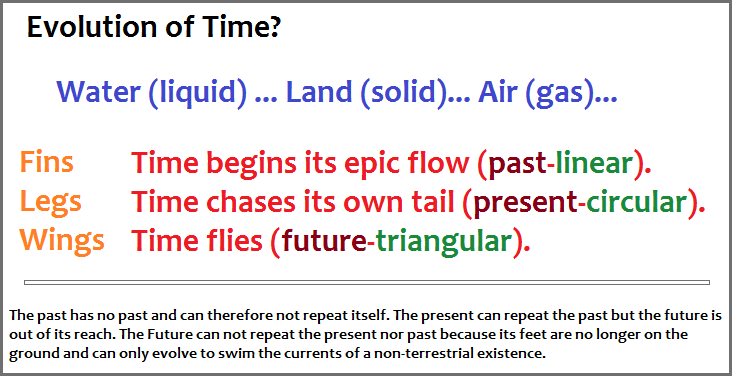
If time is unchanging, that is... invariant, this does not necessarily mean time can not undergo change of direction (such as reversal or accelerated to some future point). Change such as reversal may be possible if it occurs within the scope of an arrow's path whose parameters may be flexible as defined by permissibility of context. For example, time travel may not be a physic's problem but a genetic one. The constraints of time may be regulated by the permeability of human biology to the flow of time. If the human body is too strict a sieve, than the flow of time is constrained... particularly perhaps, in a singular direction. Such a time reversal would be wholly different than the viewing of a motion picture in reverse, though this type of reversal does occur within a time period still headed in one direction. The same goes for reversal chemical reactions that might loosely suggest a reversal of time, but actually portray a reversibility of some events as part of an assumed linear progression of time. As another example, we could say that the simple equation 1 plus 2 plus 3 equals 6 (1 + 2 + 3 = 6) as a means of adding the numbers in a given direction, even though one might add the numbers in any direction and get the same result. But with more complex equations, the ability to conduct reversibility is not so easily accomplished. Whereas inverse functions in mathematics can be intentionally created, all such function apparently occur within the motion of time in a linear direction from one point to the next. Just because a fresh water fish is swimming in an enclosed aquarium set on the floor of a salt water ocean, doesn't mean the inability of an observer to notice the see-through aquarium must nonetheless make them conclude that the freshwater fish is surviving in salt water. Appearances can be deceiving. Overall time outside any computation effort still appears to proceed in one direction even though the computational is an exercise in reversibility.
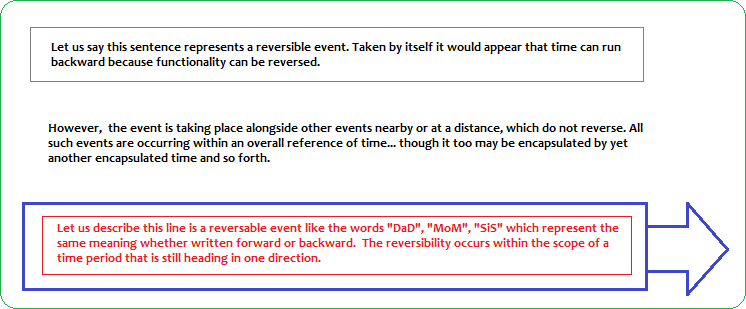
Does time exist in a relatively "steady state" configuration because past, present and future are equally proportioned, or because they are disproportioned and thus create a balance because of? Is there more past than there is present? More future than either the past or present? Do the proportions fluctuate? Are such questions testable? Let us look at some comments about eddies in order to provide an ideographic picture of this variably applicable content to a variety of contexts:
(An eddy is a) fluid current whose flow direction differs from that of the general flow; the motion of the whole fluid is the net result of the movements of the eddies that compose it. Eddies can transfer much more energy and dissolved matter within the fluid than can molecular diffusion in nonturbulent flow because eddies actually mix together large masses of fluid. Flow composed largely of eddies is called turbulent; eddies generally become more numerous as the fluid flow velocity increases. Energy is constantly transferred from large to small eddies until it is dissipated. In the lee (sheltered side) of an obstacle, eddies form only when the flow around the obstacle reaches a critical velocity; they represent a flow of fluid into the space behind the obstacle, and this inflow begins only when the general flow is fast enough to produce a lowered pressure there. Eddies or vortices (whirlpools) so produced can also cause sound. Many sounds, both natural and man-made, occur in this way. In the Earth's atmosphere, small eddies occur in the daytime when surface air is warmed by contact with the ground and then rises. On a larger scale, the huge high- and low-pressure centres that move over the Earth may be considered eddies because they are anomalous to the general circulation. These movements include tropical hurricanes and typhoons and the less intense cyclones and anticyclones of the mid-latitude westerly wind belts; the Rossby waves in the upper levels of the westerlies also are eddies. The mid-latitude cyclones, anticyclones, and Rossby waves, by transferring angular momentum (the measure of intensity of rotational motion) from the easterly to the westerly wind belts, play an important role in maintaining the global atmospheric circulation. In the oceans, eddies result from many causes, including wind blowing over the water's surface and upwelling along coasts. Source: "Eddy." Encyclopædia Britannica Ultimate Reference Suite, 2013. |
In looking at the following image, one should not get the impression that the word "vessel" refers strictly to water craft or even a "craft" that uses water as its primary medium for movement... since we use the word vessel to also describe a conduit such as a blood vessel. Hence, conduits can be viewed as vessels whether they are hollow like a drinking straw and household plumbing pipes or solid like piano or guitar strings which transmit sound by way of vibration, like the sounds of an approaching or receding train heard by placing one's ear to a train track. No less, the presumed different orbital structures of atomic particles represent different vessels denoted as elements.
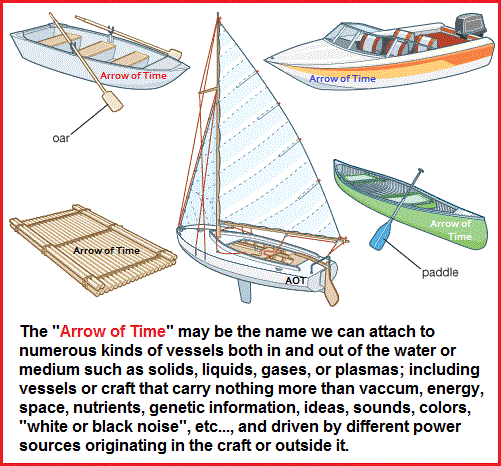
With respect to a definition of time, are we satisfied with a dictionary's list of alternative explanations of how time can be described, or should we look to develop one or more other concepts utilizing different standards of perception, experience, and knowledge? Do we prefer to simplify it, or make it appear more complex than it is or need be because this satisfies some personal issue on the subject with an intent of furthering an easily understood explanation or egotistically attempt to deliberately make a topic more complex than it need be either because we do not have a complete grasp of the subject or we are trying to claim a superior understanding? Is an "Either/Or" dichotomy or "Either/And/Or" trichotomy sufficient for our present purposes of exploration? Is there one standard definition of time that can satisfy all perceptions? Do we simply defer to those philosophers who have studied the concept from one or another conceptual imperative, or do we prefer to take up our own walking stick and plod further, though we too may cross the paths of others and walk for a time along a similar cobblestone trail predating the Roman Empire era, human biology or the present Universe as we know it?
And oh what a tangled web Time may weave if it is like an imp trying to deceive us of its nature like the task of identification set forth by Rumpelstiltskin to a young woman who is given three attempts to guess his name.

Did Time have a creator or merely a point of creation which further unravels into an interlinked mesh that can be vibrated and act like a clock's swinging pendulum? And though most appear to uncommonly think in terms of a spider's web containing holes or imaginatively consider the webbing to be constructed of a hollow system of conduits, this may be how time is constructed... unless one prefers the oft' told tale that it is an arrow. Does Time have a guardian with an unknown name and features or attributes though humans are inclined to use anthropomorphism and describe a "Father Time"? Is time like a spider waiting for us to pluck its strings though we have sometimes used the term Charon identified as a male with a boat on the river Styx? (A river which was identified by Hesiod as the daughter of Oceanus and the mother of Emulation, Victory, Power, and Might. ["Styx." Encyclopædia Britannica, 2013.])
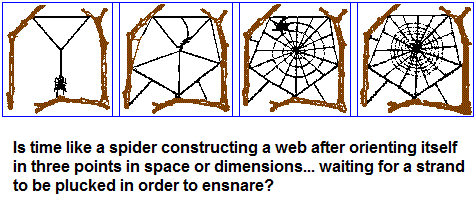
Do we start from a premise that time had a beginning and thus try to frame our views in a similar start-to-finish profile within the parameters of some time-labeled or time-referenced historical attribute confined to biological, geological and/or planetary events as far as we have thus far surmised in the history of human inquiry? (An example of this is the frequent portrayal of time travel movies depicting an event in history that is similarly well-known by different peoples in different cultures so as to increase the possibility of product disbursement to be consumable by a variety of audiences.) Or do we permit ourselves to indulge in piece-meal representations from multiple subject areas though some readers are not accustomed to psychologically flittering about like a butterfly, dragonfly, firefly or some other insect whose behavior appears regulated more by some instinct than any conscious purpose? Is one discussion of time more important than another or are they all little more than whittling a piece of stick as similar to doodling... or presented in the fashion of some used tea leaves, animal entrails, or lazy afternoon cloud reading divination exercise? And yet, what if we intentionally refrain from using familiar references to time including time dilation theories obsessed with comparing clock differences involving Einstein's Special Relativity as if it were some inviolable standard? How is it possible to think of any new ideas of we simply defer to someone else whom we interpret as some sort of authority figure whose perspective is felt to be foremost?
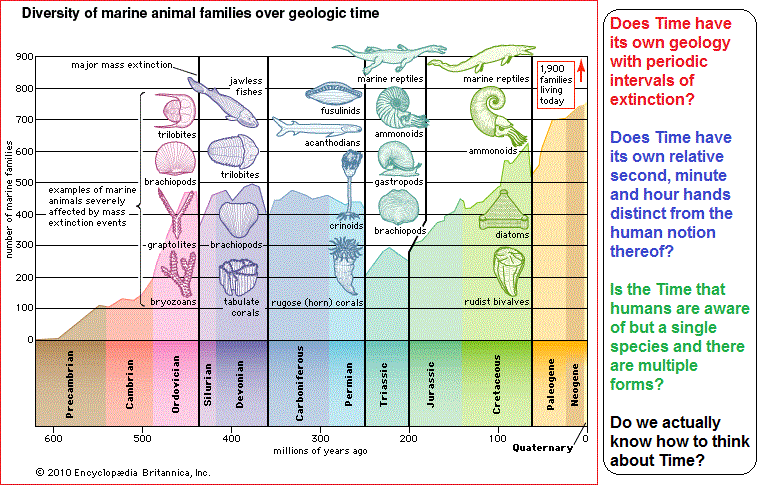
Does the subject materials of mathematics, biology, physics, philosophy, etc... have an inherent measure of time even if we humans are unable to recognize it? Does the environment force certain standards of enumeration such as two of this or three of that, etc., which involves its own form of conservation... whereby limitations of numerosity and thus time are imposed as survival requirements in a decaying environment? Is this why a circle is measure as 360° and not 12000? Is this why a clock has 12 numbers and not 400? Is time conserved differently in different environments or is it the same everywhere? Is the measure of time arbitrarily determined by one's biology and environment, with social conditions imposing restrictions and regularity according to those who are in an authoritative position to force compliance standards for purposes of control and manipulation... but the public may not be able to easily alter? Are there three central periods of time such as past-present-future to which are aligned inherent numerical values... thus indicating that Nature enforces number and thus time on Nurture?
As an added feature of commentary regarding Time and Numbers, I came across a short discussion in a book entitled "Numbers and the Making of Us" (Counting and the course of human culture), authored by Caleb Everett, © 2017 by the President and Fellows of Harvard College. (pages 11-17) I have placed it here verbatim, since it references both time and numbers. You may or may not agree with everything that is written, but it remains a useful point of reference for consideration:

...The role of numbers in our temporal perception is more apparent, though, when we consider the passing of time at its most basic level—apart from how we enumerate years. This consideration requires a brief digression into our general understanding of time. In some way, time is a difficult notion to grasp as it is inherently abstract. What does it mean to perceive or feel time? Well, it turns out, it depends on whom you ask and what culture they are from, or which language they speak. Recent research has demonstrated that time is conceived of in disparate ways across some populations. Next, I address some of this cultural variation, and then I will suggest that numbers have played an ineffable role in shaping the culturally variable experience of time. We often talk about the 'passing' of time or time 'passing by.' In fact I have done so in preceding paragraphs, and I doubt you considered such phrasing unusual. We also speak of time moving 'slowly' or 'quickly,' but clearly all these manners of speaking are metaphorical. Time does not really move, nor do we move through it. Cognitive scientists established some time ago that humans have a pervasive tendency to utilize concrete things, such as objects moving spatially, to metaphorically describe abstract aspects of our lives, like time. So we can talk about the 'movement' of time, or conversely about 'going through' a tough time, or of 'seeing' a difficult time 'ahead,' or of our inability to go 'back' to the past, or of choosing the right career 'path,' or of facing a fork in the 'road' of our lives, and so on. For speakers of English and many other languages, there are countless expressions that reflect and reify spatial interpretations of time. And most prominent amongst these metaphorical orientations is the one that pervades the examples just given, in which we face the future as time passes through us. It turns out, though, that for speakers of some languages, time does not work this way. For speakers of Aymara and several other languages, the future does not lie in front of the speaker. In fact, for the Aymara the future lies behind the speaker, while the past is located metaphorically in front of the speaker. This orientation is evident in various expressions about time and in the hand gestures fluent Aymara speakers make when talking about past and future events. (Arguably, such a metaphorical orientation maps more directly onto the human experience since we can already 'see' what has happened in our past.) So, some humans perceive the 'movement' of time in a manner that seems diametrically opposed to the way we describe it and perceive it. The malleable spatial basis of temporal thought is further evident when we consider another way in which we can metaphorically depict time, namely, as moving from left to right along a measurable line. In our culture and others, there are myriad ways in which time is depicted as such. These include calendars, the progress bars on Netflix and YouTube, timelines in history books, and so forth. And robust experimental evidence suggests that such default symbolic practices impact how we perceive time. For example, when Americans are given a set of pictures depicting events at different stages (for instance, pictures of a banana being peeled and eaten) and are asked to orient those pictures from first to last, they typically place them in a left-to-right order so that the earlier images are closer to the left side of their own body. When members of some other cultures are given the same task, however, the ordering changes. Recently linguist Alice Gaby and psychologist Lera Boroditsky found that, in the Thaayorre culture on the Cape York Peninsula, people order the pictures not from left to right, nor from right to left (a pattern that surfaces in some cultures). Instead, they orient the pictures according to the trajectory of the sun, with earlier images being placed toward the east and later ones toward the west, regardless of the direction the person organizing the images is facing. Such findings reflect an important point: How we think about time is largely a matter of cultural and linguistic practice. And here is where numbers come into the story of how we make sense of this fundamental facet of our lives, because numbers clearly impinge on how we think about the 'movement' of time. Whether we think of time as passing through us or as moving along a timeline in front of us, its 'movement' is divisible and countable. Think again of progress bars in online videos and how numbers (denoting minutes and seconds) track the icon that represents the moment being displayed in the video. In fact, numbers are ubiquitous in spatial, symbolic representations of time like left-to-right calendars and timelines. This number-centric conceptualization of time arguably governs our lives. What time is it? For me, as I write these words, it is 10:46 A.M. on the east coast of the United States. Since it is that time of day, I am in my office, at my desk, rather than at home or some other place. But what does that time really mean? Well, it means it has been ten hours and forty-six minutes since midnight, sure, but that is a tautological restatement. What are hours? What are minutes? In truth, they do not exist apart from our mental and numerical experience. They are simply an arbitrary means of quantifying our existence, of dividing the metaphorical passing of time into discrete units. They are an indication of the fact that humans at some point chose to quantify time, to number moments of experience. Time may be real, existing apart from our own experience, but hours and minutes and seconds exist only in our minds, as a way to engage with the world. This means of engagement is itself due to particular linguistic and cultural traditions. Such time units as hours, minutes, and seconds are actually the detritus of ancient number systems. These units are really just linguistic vestiges of extinct civilizations. Consider the division of each of the earth's rotations, each day into 24 hours. Why is each day so divided? There is no astronomical motivation for this division, after all, and we could in theory have any random number of hours per day. But our time-keeping system owes its existence in large part to a tradition begun by the ancient Egyptians, who developed sundials more than 3,000 years ago. Those sundials were designed to partition the daylight into twelve equal portions. This twelve-fold division was simply a by-product of the Egyptians' choice to divide the daylight in a culturally appropriate manner, as measured by shade along sundials. The choice allowed for ten divisible units of sunlight from sunrise to sunset, a natural choice since ancient Egyptian had a decimal number system like our own. Yet the sundial creators also added a unit each for dawn and twilight, the periods of the day that were not dark but in which the sun was not visible over the horizon. The simple decision of the Egyptians to divide daylight in such a manner yielded units of time based around the number 12, giving days a duodecimal feel. As we will see in Chapter 3, there are many bases in the world's spoken number systems, and duodecimal systems are pretty uncommon (and somewhat confusing to many people familiar with, say, decimal systems). Yet, because of the choice made by ancient Egyptian timekeepers, our language and thought about time are based in large part on a duodecimal-like system. This system is now firmly ingrained in our lives and enforces a certain perspective on our days. The existence of twelve-hour nights is also due to the Egyptians, as is, more indirectly, the 24-hour day/night cycle so familiar to us all. The latter system was more formally codified by Greek astronomers in the Hellenistic period, though hours of an exact and equal duration could not be appealed to until precise time-keeping mechanisms were invented. (The pendulum clock, a key innovation in time-keeping, was not created until the mid-seventeenth century.) Ultimately, then, the existence of hours is a historical accident. Had the Egyptian sundials originally separated daylight into tenths instead of twelfths, we would have ten major time units per day and night, respectively. The earth's rotations would be divided into twenty 'hours.' In fact, a decimal-based time-keeping system was implemented in France immediately following the revolution, but the system failed to catch on due to the cultural entrenchment of hours and minutes. It is apparently easier for a nation to dethrone a monarchy and decapitate a sizeable portion of its citizenry than to reorient itself to new time units. Minutes and seconds are also the result of culturally and linguistically contingent decisions made long ago. These units of time owe themselves to the sexagesimal (base-60) system employed by Babylonians and, before them, by Sumerians. These cultures appear to have been the first to use such a base for astronomical calculations, for reasons that remain nebulous. Some believe the sexagesimal system gained prominence in Mesopotamia because it is neatly divisible by 1-6, as well as by 10, 12, 15, 20, and 30. Others think such base-60 systems likely arose because humans have five digits on one hand to count the twelve joints on the non-thumb fingers of the other hand (and 5 x 12 = 60). Regardless, sexagesimal systems are not common. They have only developed a few times during the history of the world's languages. Yet the sexagesimal nature of the Babylonian counting system is the reason minutes and seconds last as long as they do—because those are the units of time you arrive at if you divide hours and minutes, respectively, by sixty. People can now rely o independent metrics to define seconds, for instance the duration of a predefined number of energy fluctuations in a cesium atom. This definition serves as the standard of the atomic clock. But such a metric was chosen only because it closely approximated the length of traditional seconds that were merely a by-product of an ancient number system that yielded an effective but arguably unwieldy means of referring to time. In sum, our construal of time is impacted by the metaphorical mapping of time onto space. Crucially, though, that space-based view of time is quantified in ways that are completely dependent on the existence of numbers. More specifically, this quantification is dependent on the characteristics of number systems once used in places like ancient Babylon. How we think about time—in discrete quantifiable units of hours, minutes, and seconds—is due to the features of extinct languages and cultures, features with vestiges in our contemporary lives. These vestiges continuously orient how we organize our everyday experience. So ancient numbers with eccentric characteristics continue to shape the way we experience time, this abstract yet fundamental part of life. Our lives are, after all, governed by hours, minutes, and seconds. Yet time does not actually occur in these or any other discrete units. The segmentation of time into quantifiable units is truly a figment of the human mind. This discussion of the role of numbers in shaping our perception of time is illustrative of how powerfully numbers, and differences among number systems, can impact our cognitive and behavioral lives... |
If you are a species that does not use numbers to express time, how would one do it if you are nonetheless sophisticated in your thinking? Would the lack of enumeration be an indication of ignorance, or different thought processing that may view numbers as cumbersome and less expressive as a musician, poet or artist might... or that numbers were not present in one's environment during a critical period of development which could take advantage of numerosity as a theoretical mathematician might? Does biology count and keep time within the constraints of biological, chemical and physic's domains? However, Biology, Chemistry nor Physics uses numbers to express themselves. Humans use numbers in different ways (such as one called "time") to distinguish characteristics thereof. If we view such subjects as different individuals or different individual characteristics of the same entity that process and express enumeration and time in separate ways, how are we to describe what time is if we aren't able to use common human conventions? For example, can time and number be expressed by sounds or colors? How about atomic particle type and arrangement? How about using the diversity of species as an expression of number or time? For example, how does inanimate yet animated activity such as geological processes give an account of number or time if it uses non-human language? A corollary of this is the question posed asking why thought hasn't evolved into something more pure? Do we simply say there has not been enough time for such a "language" to evolve? Can time be given or taken in order to accelerate, slow down or change direction of evolutionary development?
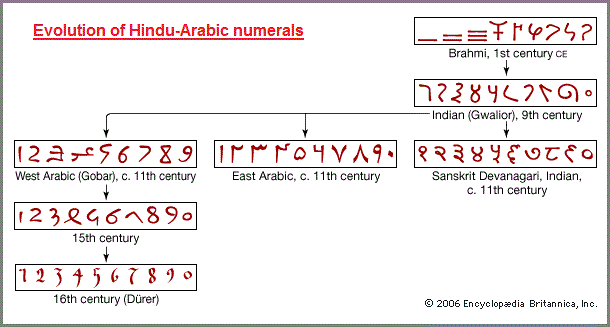
Page initially created: Thursday, 16-Nov-2017... 05:10 AM
Initial Posting: Sunday, 15th-April-2018... 7:28 AM
Updated Posting: Tuesday, 29th-May-2018... 11:55 AM
Herb O. Buckland
herbobuckland@hotmail.com
